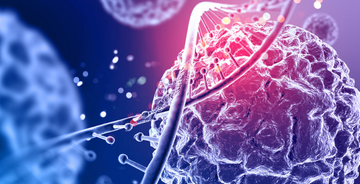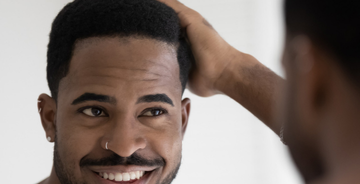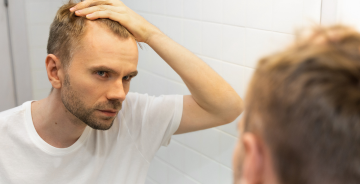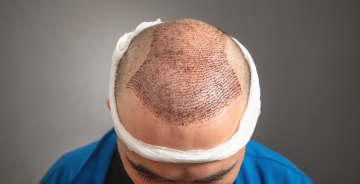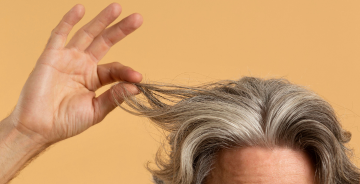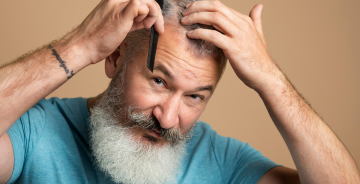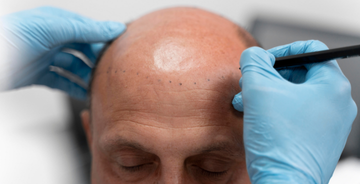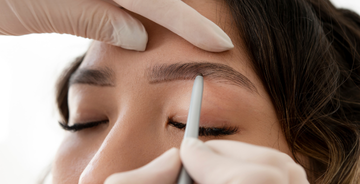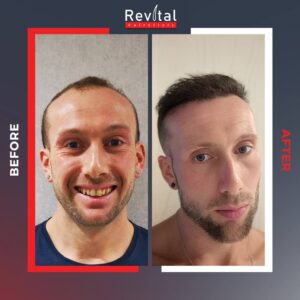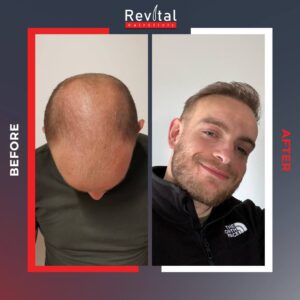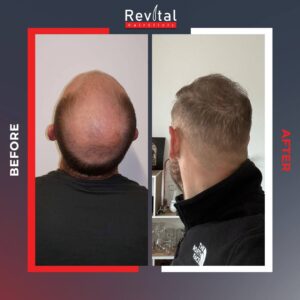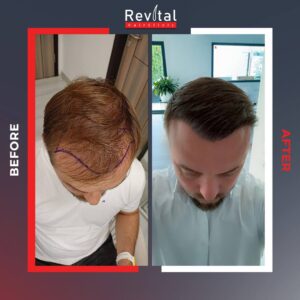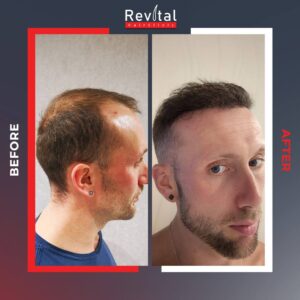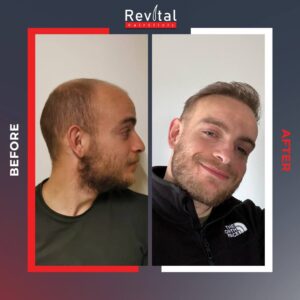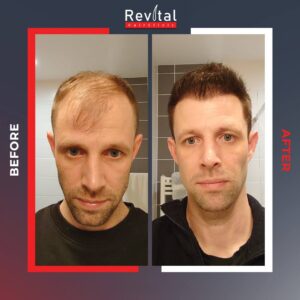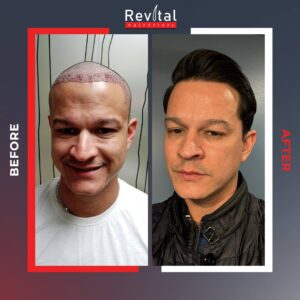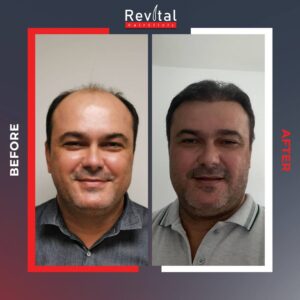Category Blog
27 May
What Is Stem Cells Hair Transplant?
What Is Stem Cells Hair Transplant? At Revital Hair Clinic, we proudly offer one of the most advanced hair restoration techniques available today: Stem Cells Hair Transplant. This innovative treatment provides a natural and scientifically backed solution to hair loss by revitalizing hair follicles and promoting new hair growth through the regenerative power of stem cells. How Does Stem Cells Hair Transplant Work? The procedure begins by harvesting a small amount of fat tissue typically from the abdomen or hip area which is then processed to extract stem cells. These regenerative cells are carefully injected into the scalp, where they stimulate and rejuvenate dormant hair follicles. For enhanced results, this technique is often combined with FUE (Follicular Unit Extraction), maximizing both density and hair growth potential. Benefits of Stem Cells Hair Transplant Natural-Looking Results: Since the treatment uses your own cells, the outcome looks and feels completely natural. High Success Rate: Stem cells support hair follicle regeneration, resulting in denser, healthier, and longer-lasting hair. Minimally Invasive: Compared to traditional hair transplant methods, the recovery time is shorter and the procedure is less invasive. Preventive Potential: Ideal for individuals in the early stages of hair thinning, helping to slow or prevent further hair loss. Who Is It Suitable For? Stem Cells Hair Transplant is ideal for individuals experiencing genetic hair loss, those seeking increased hair density, or patients who have undergone previous hair transplants but were unsatisfied with the results. A personalized evaluation with our expert medical team will determine the most suitable approach for each patient. At Revital Hair Clinic, we are committed to using the latest technologies to restore your hair and confidence safely, naturally, and effectively. Discover the future of hair restoration today.
READ MORE27 May
Afro Hair Transplant: Why Choosing the Right Hands Matters More Than Ever
Afro Hair Transplant: Why Choosing the Right Hands Matters More Than Ever Hair loss affects millions of people worldwide. But when it comes to Afro-textured hair, the approach to hair transplantation must be much more specialized. Curly, thick, and spiral-shaped Afro hair requires not only aesthetic consideration, but also technical precision. So why is Afro hair different, and what should you consider when planning a transplant? Let’s explore. The Anatomy of Afro Hair Unlike straight or wavy hair, Afro hair grows in a tightly coiled pattern — not only above the scalp, but beneath it as well. This unique spiral shape affects how follicles are extracted and implanted. Attempting to treat Afro hair the same way as straight hair can lead to serious complications, including damage to the follicles or unnatural results. That’s why Afro hair transplants demand expert knowledge, special techniques, and most importantly hands-on experience. The Risks of Inexperience Unfortunately, many clinics lack the experience needed to properly handle Afro-textured hair. This can lead to common but avoidable problems such as: Poorly designed or unnatural hairlines Grafts growing in the wrong direction Damaged or failed grafts Loss of natural curl pattern Hair transplantation is not just a medical procedure it’s an art form. And with Afro hair, it’s a form of art that requires a specialist’s touch. What Makes Revital Hair Clinic Different? At Revital Hair Clinic, we specialize in Afro hair transplants and have successfully treated hundreds of patients from African and Afro-Caribbean backgrounds. Our experienced teams in London and Istanbul understand the complexity of Afro-textured hair and apply tailored techniques to ensure optimal results. Every patient receives a fully customized treatment plan, including: Detailed analysis of the donor area Precise hairline design Graft angle and direction tailored to natural curl patterns Safe and efficient graft extraction methods The result? Full, natural-looking hair that complements your features and maintains its unique texture. Beard Transplant for Afro Hair Types Afro-textured individuals often seek beard transplants as well. Similar to the scalp, Afro beard hair has a tight curl that must be respected during the transplant. If not handled correctly, beard hair may grow in the wrong direction, appear patchy, or irritate the skin. At Revital Hair Clinic, we apply specialized techniques to ensure natural, dense, and permanent beard restoration for Afro hair types. Afro Hair Isn’t a Challenge – It’s an Opportunity Afro hair doesn’t need to be seen as a challenge when handled by experienced hands, it’s a strength. It creates a bold, defined look that stands out naturally. If you’re dealing with thinning, receding, or patchy areas, you don’t have to settle. A properly performed Afro hair or beard transplant can bring back not just your hair, but your confidence too. Remember: Afro hair needs to be approached with respect and precision. When done right, the results can be nothing short of life-changing.
READ MORE23 Apr
What to Expect on the Day of Your Hair Transplant Procedure
What to Expect on the Day of Your Hair Transplant Procedure Understanding what will happen on the day of your hair transplant is crucial for managing your expectations and reducing anxiety. Before the Procedure You’ll start the day with a consultation with your surgeon. This includes finalizing the treatment plan and confirming the donor and recipient areas. You’ll be given instructions on how to prepare, including avoiding food and drink for a few hours before the procedure. During the Procedure The surgery will take place under local anesthesia. The surgeon will remove hair follicles from the donor area and implant them in the bald or thinning areas. This process may take anywhere from 4 to 8 hours, depending on the size of the transplant. After the Procedure Once the procedure is completed, you may experience some mild swelling and redness. Most patients can return home the same day, though you will need someone to drive you if anesthesia is used. Rest and follow post-operative care instructions for the best recovery. Conclusion The day of the hair transplant is relatively straightforward with proper preparation. By understanding the steps, you can feel more comfortable and confident going into the procedure.
READ MORE23 Apr
What is Hair Transplantation
The Role of Nutrition in Hair Growth Post-Transplant Hair health is deeply affected by what you put in your body. After a hair transplant, the right nutrition can help speed up recovery and promote healthy hair growth. Essential Nutrients for Post-Transplant Hair Growth Biotin: Biotin (vitamin B7) is crucial for healthy hair growth. It strengthens the hair follicles and encourages faster regrowth. Protein: Hair is primarily made of protein, so a protein-rich diet can aid in rebuilding hair fibers and promoting new hair growth. Vitamin D: Vitamin D plays a key role in the hair growth cycle, and a deficiency can contribute to hair loss. Iron and Zinc: These minerals help in maintaining healthy blood circulation and providing nutrients to the hair follicles. Conclusion A balanced diet with the right vitamins and minerals can enhance the results of a hair transplant. Make sure to consult with your surgeon about any additional supplements you should consider for optimal results.
READ MORE23 Apr
Understanding the Different Stages of Hair Growth Post-Transplant
Understanding the Different Stages of Hair Growth Post-Transplant After a hair transplant, understanding the stages of hair growth can help you manage your expectations and ease any anxieties you may have. The hair growth process after a transplant goes through several stages, and each stage plays a crucial role in achieving healthy and strong hair. Stage 1: Shock Loss (1-3 Months) Immediately after a hair transplant, many patients experience shock loss. This is when the transplanted hair falls out within the first few weeks following the procedure. Shock loss is a normal and temporary occurrence, as the hair follicles adapt to their new environment. This usually happens between 2 to 3 weeks after the procedure and can last for several months. Stage 2: New Hair Growth (3-6 Months) After shock loss, new hair starts to grow from the transplanted follicles. However, the growth is usually quite slow at first. Initially, you may notice fine and short hairs appearing, which are part of the early growth phase. This stage typically happens between 3 to 6 months after the procedure. Stage 3: Thicker and Longer Hair (6-12 Months) As time passes, the new hair becomes thicker and longer. During this stage, the growth is more noticeable, and the appearance of your hair begins to improve significantly. The hair growth rate can vary from person to person, but this stage usually occurs between 6 to 12 months. Stage 4: Final Results (12-18 Months) The final results of a hair transplant generally appear between 12 to 18 months. By this time, the transplanted hair will have fully grown out, thickened, and blended seamlessly with your natural hair. The final look is natural and results in a fuller, healthier appearance. Conclusion Hair transplant recovery is a process that requires patience. Understanding the stages of hair growth can help you navigate this journey and set realistic expectations for the final results. With proper care and patience, you’ll be able to enjoy the full benefits of your transplant.
READ MORE23 Apr
Post-Transplant Hair Care: Do’s and Don’ts
Post-Transplant Hair Care: Do’s and Don’ts Proper post-transplant care is essential for the best results. Here are some important do’s and don’ts to keep in mind after your hair transplant. Do’s Follow your surgeon’s instructions carefully regarding washing, medications, and follow-up appointments. Keep the scalp clean to prevent infection, but avoid rubbing or scratching the transplanted area. Wear a loose hat or cover your scalp when going outside to avoid direct sun exposure. Don’ts Don’t engage in heavy exercise or strenuous activities for at least two weeks after the procedure. Avoid alcohol and smoking, as these can interfere with the healing process. Don’t pick or pull at the transplanted hairs, as it can damage the follicles. Conclusion By following the proper aftercare guidelines, you can maximize your chances of successful hair growth and a smooth recovery.
READ MORE23 Apr
How to Choose the Right Hair Transplant Surgeon
How to Choose the Right Hair Transplant Surgeon Choosing the right surgeon is one of the most important decisions you’ll make when considering hair transplantation. Here are some key factors to consider: Experience and Qualifications Ensure that the surgeon is board-certified and has significant experience performing hair transplants. Look for someone who specializes in hair restoration and has a proven track record of success. Patient Testimonials and Before/After Photos Patient reviews and before-and-after photos can give you an idea of the surgeon’s work and patient satisfaction. Make sure to review multiple cases to see if their results match your expectations. Consultation Process A good surgeon will take the time to listen to your concerns, explain your options, and create a personalized treatment plan based on your specific hair loss and goals. Conclusion Choosing the right surgeon is crucial for achieving the best results. Take your time, do your research, and make sure you feel comfortable with the surgeon before proceeding.
READ MORE23 Apr
How Lifestyle Choices Affect Hair Loss and Hair Growth
How Lifestyle Choices Affect Hair Loss and Hair Growth Hair loss and hair health are influenced not only by genetics but also by your lifestyle choices. Your diet, habits, sleep patterns, and stress levels can significantly affect the growth or loss of your hair. In this article, we’ll explore how lifestyle factors contribute to hair loss and what you can do to improve hair health. Bad Habits That Contribute to Hair Loss Poor Diet: A diet lacking in essential nutrients can weaken hair follicles and accelerate hair shedding. Vitamin and mineral deficiencies, particularly in protein, iron, zinc, and biotin, can lead to thinning hair. Smoking: Smoking reduces blood flow to the scalp, which hinders the delivery of oxygen and nutrients to hair follicles, leading to hair loss. Excessive Alcohol Consumption: Drinking too much alcohol can interfere with nutrient absorption and negatively affect hair growth. Lack of Sleep: Poor sleep disrupts hormone balance, which can contribute to hair thinning and loss. Healthy Habits That Promote Hair Health Balanced Diet: To support hair health, eat a diet rich in protein, vitamins, and minerals. Biotin, zinc, iron, and omega-3 fatty acids are especially important for hair growth. Regular Exercise: Exercise improves circulation, ensuring that more oxygen and nutrients reach your hair follicles. It also helps to reduce stress. Adequate Sleep: Sleep is essential for overall health, including hair growth. Aim for 7-8 hours of quality sleep to allow your body to repair and regenerate, promoting hair growth. Stress Management: High stress levels can lead to hair loss. Incorporating relaxation techniques such as yoga, meditation, or walking in nature can help reduce stress and improve hair health. Conclusion Your lifestyle choices play a significant role in both hair loss prevention and hair growth. By adopting healthy habits, you can improve the condition of your hair and support the effectiveness of any hair transplant treatments you’ve had. Taking care of your body and mind will help you achieve and maintain healthy hair.
READ MORE23 Apr
Hair Transplantation Myths and Facts
Myths About Hair Transplantation Hair transplantation is often misunderstood, and there are many myths surrounding the procedure. Here, we’ll explore some common myths and separate fact from fiction. Myth #1: Hair Transplantation is Painful Many people believe that hair transplants are extremely painful. However, the procedure is performed under local anesthesia, meaning you won’t feel pain during the surgery. Post-procedure discomfort is usually minimal and can be managed with pain relievers. Myth #2: Transplanted Hair Doesn’t Look Natural With modern techniques like FUE and DHI, transplanted hair looks completely natural. The hair follicles are implanted carefully and blend seamlessly with your existing hair, resulting in a fuller and more natural appearance. Myth #3: The Results Are Immediate While some initial hair growth can be seen within a few months, the full results of a hair transplant typically take 12 to 18 months to appear. The process of hair regrowth occurs in stages, and patience is required for optimal results. Conclusion Hair transplantation is a safe and effective procedure when done by a qualified professional. By understanding the myths and facts, you can make a more informed decision about the treatment.
READ MORE23 Apr
When Do We See the Exact Results of Eyebrow Transplantation?
When Do We See the Exact Results of Eyebrow Transplantation? Eyebrow transplantation is a popular and effective procedure for individuals looking to restore or enhance their eyebrows, whether due to overplucking, genetics, trauma, or medical conditions. While the procedure itself is relatively straightforward, many patients are curious about one thing: “When will I see the final results?” In this blog post, we’ll break down the healing timeline, explain what to expect at each stage, and provide expert tips to ensure the best possible outcome from your eyebrow transplant. A Timeline of Eyebrow Transplant Results Immediately After the Procedure (Day 0–7) The transplanted area may appear slightly red or swollen. Tiny scabs will form around the implanted grafts. You might feel some mild discomfort or tightness. Important: Avoid scratching or rubbing your eyebrows during this stage to prevent dislodging the grafts. Week 2–3: Shedding Phase (Shock Loss) This can be a bit alarming, but it’s completely normal! The newly transplanted hairs typically fall out around this time. This process is called shock loss and is expected. Don’t worry – the follicles are still intact beneath the skin. Month 1–3: Dormant Phase It may seem like nothing is happening, but the follicles are settling in and starting to regenerate. You won’t see much visible growth during this period. Patience is key – this is part of the natural hair cycle. Month 3–6: Initial Regrowth The first signs of new hair growth usually begin to appear. Hairs may be thin, fine, or even grow in at different angles at first – this is also normal. At this point, some styling or trimming may be needed as the new hairs grow. Month 6–9: Noticeable Improvement Hair growth becomes more consistent. The brows start to look fuller and more natural. You’ll see a significant improvement in density and shape. Month 9–12: Final Results By this time, you should see the final results of your eyebrow transplant. Hairs have matured, thickened, and blended in with your natural brow hair. You can treat these hairs like natural brows – trim, shape, and even tint them if desired. ✅ Tips to Maximise Your Results Follow post-op care instructions from your clinic carefully. Avoid excessive sun exposure in the first few weeks. Stay patient – hair growth takes time. Schedule follow-up appointments to monitor progress. Maintain a healthy diet to support hair health. ⚕️ Final Thoughts Eyebrow transplantation offers permanent, natural-looking results, but like any hair restoration procedure, it requires time. While you may start to notice early changes around the 3-month mark, true final results are typically visible between 9 to 12 months post-procedure. Everyone’s hair growth cycle is different, so your personal timeline might vary slightly. The key is to remain patient and consistent with aftercare – your dream brows are well on their way!
READ MORERevital Hair Clinic © 2024

